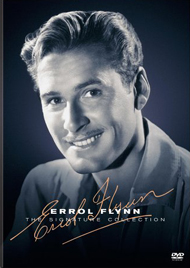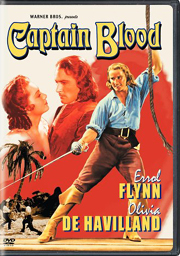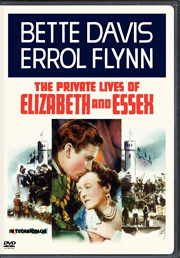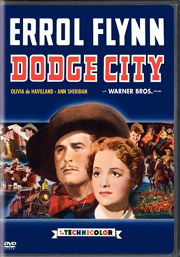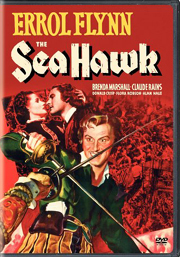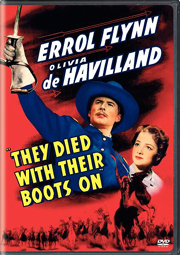| Release List | Reviews | Price Search | Shop | Newsletter | Forum | DVD Giveaways | Blu-Ray/ HD DVD | Advertise |
| Reviews & Columns |
|
Reviews DVD TV on DVD Blu-ray International DVDs Theatrical Reviews by Studio Video Games Features Collector Series DVDs Easter Egg Database Interviews DVD Talk TV DVD Talk Radio Feature Articles Columns Anime Talk DVD Savant HD Talk Horror DVDs Silent DVD
|
DVD Talk Forum |
|
|
| Resources |
|
DVD Price Search Customer Service #'s RCE Info Links |
|
Columns
|
 |
Errol Flynn: The Signature Collection
|
||||
A few seasons back fans were lamenting the dearth of classic Warner Bros. films on DVD, a situation that is rapidly turning around. The special editions and boxed sets are now flying out of Burbank so quickly that one has to keep the budget in mind while perusing what to buy. Errol Flynn hits the racks this month with five top titles and a feature-length TCM documentary. All of the films appear to be their original full-length versions (some were cut for reissue) and are bundled with attractive Warners goodies - interview docus, trailers, and the Leonard Maltin- hosted Warner Night at the Movies selections of newsreels, cartoons and short subjects.
|
||||
Errol Flynn's rise to stardom was one of those instantaneous Hollywood miracles - after two or three pictures he became the obvious pick for Captain Blood, a revival of the swashbuckling Douglas Fairbanks- style that hadn't been given a good outing since the silent era. Everything clicked in Captain Blood: the dashing Flynn, his up-from-almost-nowhere costar Olivia de Havilland, the great music of Erich Wolfgang Korngold. What keeps the picture exciting today is the superior direction of Michael Curtiz, who found a dynamic style for action that hasn't been bettered.
Captain Blood must have been one heck of a thrill ride in 1935, bursting the screen with tall-masted ships at battle, sword duels, broadside cannonades and flashy derring-do. Both Errol Flynn and Olivia de Havilland are a bit unsure of their footing - he looks odd in some makeup in early scenes, and the Warners stylists don't always get her image right either - but they lighten the drama with a pairing made in romance-novel heaven. Casey Robinson's screenplay surprises us with a number of structural felicities - the excellent use of Flynn's supporting cast of 'volunteer pirates' especially - but the best is a terrific symmetrical idea: Dr. Blood is humiliated by being auctioned to a giggling colonial butterfly, but gets to turn the tables on his lady fair when he buys her hostage contract from a fellow pirate. Arabella isn't as amused when Blood looks over his newly-purchased property - her. Touché Lionel Atwill is an okay baddie, while Basil Rathbone impersonates a lusty French corsair with ease (his superior fencing skills are also much in evidence). Guy Kibbee is good as Blood's gunner, especially so if all one has seen him play are fat sugar daddies in Golddiggers movies. Ross Alexander is a standout as the pirate navigator, and we were saddened to learn from the docu that he committed suicide not long after finishing the picture. J. Carroll Naish has a nice bit, and famed athlete Jim Thorpe is said to be among the pirates. As in a silent movie, the film has frequent text titles supered over the image. The new pirate's popularity is hyped in a battle montage with the word "BLOOD!" splashed across the screen three times. As it turns out, a healthy number of mass battle shots and special effects scenes were recycled from Warners' silent swashbucklers; one can tell by the slight increase in grain. Don't confuse those with several entire sequences that are more contrasty. Those were restored (in the 1980s?) after going missing for fifty years, so if you remember Captain Blood only from pre-cable television viewings, this is going to be a revelation. The show ends with an agreeably anachronistic little skit by Blood and Arabella that seems out of character for both of them, yet is perfect for this new kind of romantic escapist adventure. The DVD of Captain Blood is in fine shape, with only a few nicks here and there and an occasional scratched shot that may have been scratched in the first release. Restored scenes and stock shots do tend to shift in quality. Audio enhancement brings out the Korngold scoring, which tended to get lost in the hiss of old 16mm prints. The Warner Night at the Movies extras include a Metro newsreel that implies that Roosevelt's New Deal is a failure. There's also a funny Porky Pig cartoon, although he only does a cameo in it.
|
||||
The Private Lives of Elizabeth and Essex is first and foremost a stage play, which puts Flynn at a disadvantage with his co-star Bette Davis. What might seem more or less equal billing is soon revealed to be a Davis vehicle with Flynn in support, even though the actor does fine work in a role where he never draws a sword in anger.
Although a fine drama, The Private Lives of Elizabeth and Essex generally isn't counted among Flynn's favorite films, and I'm almost surprised that it wasn't first considered as part of a Bette Davis collection. Almost all of the show takes place within the Queen's Whitehall castle, with occasional crowd noises heard from without, and we tend to click off the sets as we see them, noting which seem to be recycled from The Adventures of Robin Hood and which will be reused almost immediately in The Sea Hawk. There's a certain amount of pomp and circumstance in the court, but even Erich Wolfgang Korngold seems to know that the film needs to be more subdued, and arranges his music accordingly. It's really a series of stage encounters between the queen and her subject on the theme of the impossibility of a woman being able to be a ruler and a woman at the same time. Modern feminists would have some gripes with that assessment; looked at objectively, Essex made moves that seal his fate plain and simple. One doesn't militarily check one's queen, and then expect fair play when she gets her power back again. Essex thinks he can play with the realities of state but Elizabeth won't be dragged down to the level of a submissive lover. In this reviewer's opinion Flynn shows great promise as a straight dramatic actor, especially when making fun of Vincent Price's silver armor, or in his sober reckoning with Alan Hale's Irish chieftain - for once not playing Flynn's comic sidekick. Davis is Davis, of course, fearless in her willingness to look like the Elizabeth of paintings ... not a pretty sight. She actually shaved part of her hairline to achieve that bulbous forehead. It's amusing to see Davis and Olivia de Havilland play opposite one another, and to contrast them with their characters almost thirty years later in Hush... Hush Sweet Charlotte: When Olivia confesses her crime, Davis seems to be saying, "It's okay, because I'm going to squash you with a giant concrete pot someday." Both actresses were rebels against the studio contract system, and after the heights of Robin Hood and Gone With the Wind it must have galled de Havilland to take a step backward into what amounts to a minor supporting role. It would be years before she was able to make real career progress. Henry Daniell has a warm-up role for his snide villain in The Sea Hawk. Although she's almost unrecognizable, Nanette Fabray The Band Wagon plays an emotional lady-in-waiting, Mistress Margaret Radcliffe. That's the biggest surprise in the film. Warners' DVD of The Private Lives of Elizabeth and Essex is intact and would be a fine show if it were not for misregistered Technicolor. In at least half the shots the red part of the image hovers high and to the right, as in a badly-printed magazine page. Savant often sees a few moments like this in DVDs of Technicolor films, as most are mastered from film composites where flaws can be built-in. Quite a few closeups in Elizabeth and Essex are ruined as well; one shot of Errol Flynn looks like a 3-D photo before one puts on the viewing glasses - a bad case of double vision. The extras this time around include a Technicolor short subject (in fine shape) called Royal Rodeo with a young John Payne. It tries one's patience and begs to be skewered, MST3K style. Old Glory is a Technicolor cartoon in which a snoozing Porky Pig learns about his patriotic heritage from the fathers of our country.
|
||||
Dodge City can only be described as a big-studio superwestern, an attempt to put a fancy wrapper on the same themes as had been playing out in cheap series oaters for thirty years. Thus every scene comes with a setpiece on a big scale - a train chase, a stampede, a barroom brawl, while the writers find excuses to fit the not-particularly-American Errol Flynn into the proceedings.
Warners puts bold Technicolor and all of its resources behind Dodge City, but it still chalks up as one of Flynn's lesser vehicles, even if there's plenty of clever writing to spruce up the western clichés. Flynn's banter with de Havilland is reasonable (she looks prettier than ever in Technicolor) and Alan Hale's escapades with the Pure Prairie League get some genuine laughs, but most of what we see is ho-hum stuff. A nice cattleman (John Litel) tries to do business with the villain early in the production, and he might as well hang a "shoot me" sign around his neck. The hero minds his own business until an innocent kid (weepy-blubbery Bobs Watson) bites the dust. The activist newspaper publisher (Frank McHugh) doesn't see the danger even when he's told that the despicable baddie is gunning for him. And the peace-loving citizens of Dodge turn into a vigilante mob. Flynn looks odd as a cowboy, wearing always-neat color coordinated outfits and a hat that needed to be re-thought. There are odd references to Shakespeare and possible service in India (!) to provide a reasonable explanation for his clipped speech, but nobody is fooled. Flynn's sheriff of course defends widows (Gloria Holden, once Dracula's Daughter) and upholds the rights of Indians, although I'm not sure we ever see any. The screenplay finds little to do for a ton of acting talent: Victor Jory, Douglas Fowley and Ward Bond are colorless baddies, while a dozen familiar faces fill out other stock chores. The biggest waste is Ann Sheridan, who sings a couple of songs but really has no function in the story at all. If anything, the film is overpopulated. Guinn "Big Boy" Williams serves as a second-string sidekick under Alan Hale and doesn't contribute that much either. It's a pleasant enough westerm with few surprises; even Max Steiner's score isn't all that memorable. Warners' DVD of Dodge City is bright and colorful but plagued with some of the same Technicolor misregistration problems that dogged The Private Lives of Elizabeth and Essex. Viewers demanding to know why these problems aren't addressed need to know that the only fix is an extremely expensive digital recomposition of the three Tech matrices, and that's only possible if they exist in good shape. In the past, only The Wizard of Oz and a few other tip-top titles have been retooled through that process. Warner Night at the Movies includes featurettes appropriate for 1939. Sons of Liberty is a Michael Curtiz- directed short subject starring Claude Rains, Gale Sondergaard and Vladimir Sokoloff with an interesting theme - showing that Jewish Americans donated funds to keep the American Revolution afloat. The funny cartoon is Dangerous Dan McGoo, starring a dog who speaks with Elmer Fudd's voice, and a Mae West- like singer doing a Katharine Hepburn imitation, even though a dissolve compares her to Bette Davis. Vew-wy confusing. The interview docu can find little to say about Dodge City beyond the obvious, and does best when describing the film's unique premiere, a star-studded junket to the real Dodge City, Kansas. Errol Flynn leads the premiere parade on horseback.
|
||||
The Sea Hawk is Flynn's best action movie and for romance rivals the crowd-pleasing favorite The Adventures of Robin Hood. The story warps history to champion the cause of England, which in 1940 was of course barely holding its own against Hitler. Thus the English effort to compete on the high seas is distorted beyond recognition, with Spain's King Philip II (Montague Love) transformed into a megalomaniac with ambitions to conquer the world. He uses devious methods in hopes of tricking the kindly Queen Elizabeth into maintaining an isolationist, diplomacy-not-seapower stance long enough to clobber England with the Spanish Armada. Among several minutes later dropped from the film (but restored here) were more references to England's righteousness in battle. If The Sea Hawk was shown in Franco's Spain, I'll bet that creative dubbing was used to nullify this propaganda.
The Sea Hawk is the movie that should be shown to young fans of George Lucas' Star Wars franchise. The exciting Korngold music and its instrumentation were the obvious model for John William's score, and those familiar with Star Cruisers and light saber battles will be thrilled to see the original inspiration. The Sea Hawk is Flynn's last classic pirate adventure at Warners and it has a sense of effortless grace: We see many repeated situations and themes that seem inspired under Michael Curtiz' confident direction. Flynn's smiles have a touch of self-awareness but the show is played in full earnest. Flora Robson's Queen adds class, and the baddies are split between the venal Henry Daniell and Claude Rains' determined spy, who still loves and understands his daughter's attraction to the enemy pirate Thorpe. Politically the movie is all over the place, reflecting the conflicting emotions felt in America over the idea of isolation. The Queen secretly condones the actions of the privateers, just as FDR supported the Flying Tiger mercenaries and found ways to covertly aid England when doing so in public would have been political suicide. Thorpe maintains that England and Spain are already at war, and his excuses about freeing galley slaves are just for expedient argumentation. King Phillip's Armada is almost complete, a real Weapon of Mass Destruction that shouldn't be ignored. Michael Curtiz' keen visual storytelling has been honed into a fast-paced entertainment machine. The film never seems rushed but also never slows down; his moving camera is forever finding new angles or prowling across the outside of Flynn's ship to find Brenda Marshall hovering at a doorway. The director makes a dramatic highlight out of the expository moment of Doña María getting the bad news about Thorpe's capture by simply allowing the Korngold music to lead the way. It starts with a love song and ends with an almost painful musical reprise as the ladies-in-waiting back out of the room in a half-curtsy. Olivia de Havilland may be Flynn's perfect mate but the dark and soulful Brenda Marshall is an appropriately romantic substitute. Unlike de Havilland's assertive females, Marshall is the believably demure and long-suffering type, and her love scenes are just as affecting. Writers Howard Koch and Seton Miller give Flynn a chorus of admiring sailors to sing his praises and supply the needed peppy dialogue for action scenes. By this time Alan Hale was established as Flynn's official sidekick, and he's joined by William Lundigan and others. There are a few Latins playing the Spaniards - Gilbert Roland, Pedro de Cordoba - but there's almost no Spanish flavor to most of the mispronounced dialogue. In this fantasy Spain, the Grand Inquisitor (Fritz Lieber) looks like Death in an Ingmar Bergman movie - or the evil Emperor from Star Wars. Look closely and you'll see many action shots repeated from Captain Blood, yet The Sea Hawk is no action retread. The scenarists lift the galley oarsmen from Ben-Hur to excellent effect, as those nasty Spaniards delight in whipping the poor English slaves 'til they drop. All of which makes Flynn's timely escape all the more exciting. When the crew leaps into singing one of Korngold's fanfare-like choruses, we're too thrilled to wonder why they're making so much noise while sneaking out of a Spanish harbor! Warners' DVD of The Sea Hawk looks and sounds marvelous, with only the restored scenes dropping a bit in visual quality as they remind us of what was cut for later double-bill reissues. The entire Panama sequence is presented in Sepia-Tone, just as described in the old film books. Thank heavens that nobody thought to liquidate 'extraneous' film elements from the Warner vaults, as happened with the old Paramount library, or we could have been stuck with bad dupes for Television printing. It's often been asked why The Sea Hawk wasn't filmed in color. Beyond the general expense and difficulty, it was probably because shooting in color wouldn't have allowed the re-use of the old stock footage. Instead of a cartoon, this time we get a really dippy featurette about an ordinary Jane who makes it big in Hollywood and eventually wins an Oscar. It was written by Ed Sullivan, of all people, and stars Joan Leslie.
|
||||
The words "don't even go there" are the best response to the historical context of They Died With Their Boots On, a towering pack of lies about General Custer's career, life and battles. Yet Warners' Indian War epic is still one of the most entertaining movies Flynn made. His final teaming with Olivia de Havilland is as fresh as his first, and director Raoul Walsh proves every bit as efficient with the Warners action style as was Michael Curtiz, substituting added energy and character for Curtiz' more refined touches. What staggers us now is the tremendous gall of filmmakers who have no trouble whatsoever rewriting history to the convenience of the moment. The script covers all bases, paying homage to the Confederacy so as not to offend southern audiences and even offering some some backhanded compliments to the native Americans. At one point one of Custer's officers - an Englishman, gotta cover all political bases - states that the only real Americans are the native Indians themselves, and Custer agrees. The real heat is reserved for nasty corporate businessmen (no kidding) who will do anything to make a profit, including send thousands of whites to their doom in Indian territory, after selling guns to the "dirty redskins" (the words of Charley Grapewin's grizzly scout character, not mine).
They Died With Their Boots On is the Warners' style at its peak. There's enough story here for a ten-hour miniseries, but even though it's all packed into 140 minutes nothing seems unduly hurried. Every moment gets its just due, and then the story moves on. De Havilland's noble wife is so well established in some amusing scenes with Hattie McDaniel that her later appearances, mostly expository story-pushers, don't come off as rushed. Characters like Sydney Greenstreet's fat General and even Ulysses S. Grant are all given a few moments to make a proper impression. Forward momentum is the key: Nobody stops to rehash events that have already passed. Errol Flynn's dashing personality adapts so well to the flamboyant Custer that it is his image that persists even in the face of later attempts to demythologize the (take your pick) hero / villain. Discounting Robert Siodmak's disastrous Cinerama biography Custer of the West, which can't seem to get anything right, the outrageous lampoon of Richard Mulligan in Arthur Penn's Little Big Man pleased the revisionists but never caught on. We seem as eager to assess Custer for what he was as we are to look more closely at the politics behind the War of 1812, or the Alamo. Flynn's Custer effortlessly contains a ridiculous number of inconsistencies. He's a born glory-hound but a man of honor who won't sell out to corruption in business or government. He gladly battles Indians but constantly champions their nobility and injust treatment. He's a drunkard forever closing the bars ... and would rather eat onions than drink anyway. They Died With Their Boots On probably gives historians heart attacks and makes Native American activists spit blood. The charismatic Flynn makes their protests seem beside the point. Only one thing unites audiences in the face of such contradictions, and that's a good old-fashioned American Death Wish. Both Libby and George approach his coming dee-mise like a God-willed suicide pact, and Custer puts his command in order by doing cute things like offering one officer a chance to retire and dragging an old enemy into the fire with him, while quoting solemn oaths of honor. Flynn's Custer doesn't really have a character arc, but the film does make a remarkably efficient change from comedy to stern-faced drama. Custer keeps his dignity even though the Seventh rides to glory by way of a simplified trap that every six year-old in the audience can see coming. In this version, you see, Custer knew it was a trap and so wasn't really trapped, understand? In a pleasant contrast with The Charge of the Light Brigade, a tale with a very similar structure, Walsh and Flynn don't play up the heroics in Custer's violent end. They Died With Their Boots On is a heavy-duty workout for the second unit, which sees most of the western end of the San Fernando Valley (especially Stony Point) enlisted to stand in for everything from Dakota's Black Hills to the fields of Pennsylvania - You know, the brownish parts of Gettysburg, with all the dry eucalyptus trees. In the big battle, don't forget to note the clouds that are frequently superimposed to make backgrounds match. They can be seen remaining static as shots pan, and showing through an occasional cavalryman's hat. And one has to appreciate the spectacular aerial shot of Custer's troop moving in the foreground while a thousand mounted Indians outflank them in the distance. Those faraway horses seem to be moving at at least eighty m.p.h.! In the midst of all this is Savant's favorite Flynn horseriding shot: He reins in his steed and it slides to a halt on its back legs like a skier sideswishing to a stop. Ultra-cool action, that. It almost makes one forget the audacious final scene, which outdoes John Ford's 'bury the facts' kissoff scenes in Fort Apache and The Man Who Shot Liberty Valance. Libby threatens to expose the corrupt businessman & politician with Custer's dying declaration, unless they dissolve their affairs and resign. They do, and we're to understand that that's what has kept George Armstrong Custer's true and noble role in American history secret all these years ... he was protecting the Indians in the name of America's honor, see? That script invention is too much like many real-life patriotic 'heroes' who claim that higher loyalites forbid them from telling the truth. Warners' They Died With Their Boots On is intact and great-looking on DVD. Vault materials must have been in good shape, for even dissolves and opticals have little grain. Max Steiner's robust score includes all of the "Indian" cues he repeated for fifteen years, all the way through The Searchers; the brassy main themes contrast well with the romantic music for Libby, the perfect officer's wife. They Died With Their Boots On must have seen general release in 1942, for Leonard Maltin's Warner Night at the Movies extras are all from that year. A featurette championing Army doctoring as a career stars an unbilled and very young Eleanor Parker as a spirited nurse. A Tale of Two Kitties is a cartoon with two cats that fully imitate Abbott and Costello, so much so that I'm surprised the Universal lawyers didn't have it suppressed. They square off with a proto-Tweety Pie character, and the violent results are hilarious. The interview docu wisely throws its hands up at the subject of historical accuracy and concentrates instead on the timeless appeal of the Flynn - de Havilland romantic pairing, and Flynn's preference for director Walsh over that old slave-driver Curtiz. Overall, the Errol Flynn Box is fine set of discs of films that are the sentimental favorites of huge numbers of fans. It comes with a sixth disc, a new feature-length documentary called The Adventures of Errol Flynn that takes a thorough look at his life starting with a funny introduction on a Steve Allen quiz show, standing next to Don Knotts! The detailed show has great film clips that include his first Australian film in 1932 and his disastrous unfinished William Tell in 1954. The narrator is Ian Holm; it has interviews with Olivia de Havilland and even addresses the accusation that Flynn was a Nazi spy. Turner has accumulated a fair number of these superior biographical docus; this one is directed by David Heeley. There are several good Flynn pictures still at large to make a followup second box a natural: The Charge of the Light Brigade, Dawn Patrol, Edge of Darkness, The Adventures of Don Juan, Gentleman Jim. On a scale of Excellent, Good, Fair, and Poor,
|
||||
|
On a scale of Excellent, Good, Fair, and Poor,
|
||||
|
||||
Review Staff | About DVD Talk | Newsletter Subscribe | Join DVD Talk Forum |
|
| Release List | Reviews | Price Search | Shop | SUBSCRIBE | Forum | DVD Giveaways | Blu-Ray/ HD DVD | Advertise |






